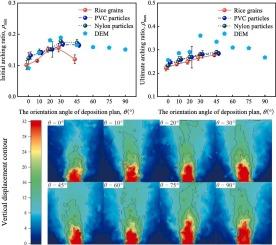Asymmetric mobilization of arching effect in granular materials: the role of fabric
IF 4.5
2区 工程技术
Q2 ENGINEERING, CHEMICAL
引用次数: 0
Abstract
We present an experimental and DEM investigation of the arching effect by focusing on the trapdoor test, with an emphasis on the effect of fabric orientation which is created by depositing particles at various directions. The results indicate that the arching effect is the weakest when the deposition plane is oriented at θ = 30°, which is manifested by the largest arching ratio for the trapdoor part and the most considerable particle movement. The arching effect mobilization is found to be asymmetric, apart from the cases θ = 0° & 90°. The arching ratio for the left bottom part is on average lower than that for the right bottom part, and the vertical particle displacement for the neighbouring zone at the left of trapdoor is comparably larger. The asymmetric mobilization of arching effect, as well as the occurrence of the weakest arching effect at θ = 30°, is also clarified.

颗粒材料中拱形效应的非对称调动:织物的作用
我们以活门试验为中心,对拱起效应进行了实验和 DEM 研究,重点研究了通过在不同方向沉积颗粒而产生的织物取向的影响。结果表明,当沉积面的方向为 θ = 30° 时,拱起效应最弱,表现为活门部分的拱起比率最大,颗粒移动最明显。除了 θ = 0° & 90° 的情况外,拱形效应的移动是不对称的。左侧底部的起拱率平均低于右侧底部,而活门左侧邻近区域的垂直颗粒位移相对较大。拱起效应的非对称调动以及θ = 30°时拱起效应最弱的现象也得到了澄清。
本文章由计算机程序翻译,如有差异,请以英文原文为准。
求助全文
约1分钟内获得全文
求助全文
来源期刊

Powder Technology
工程技术-工程:化工
CiteScore
9.90
自引率
15.40%
发文量
1047
审稿时长
46 days
期刊介绍:
Powder Technology is an International Journal on the Science and Technology of Wet and Dry Particulate Systems. Powder Technology publishes papers on all aspects of the formation of particles and their characterisation and on the study of systems containing particulate solids. No limitation is imposed on the size of the particles, which may range from nanometre scale, as in pigments or aerosols, to that of mined or quarried materials. The following list of topics is not intended to be comprehensive, but rather to indicate typical subjects which fall within the scope of the journal's interests:
Formation and synthesis of particles by precipitation and other methods.
Modification of particles by agglomeration, coating, comminution and attrition.
Characterisation of the size, shape, surface area, pore structure and strength of particles and agglomerates (including the origins and effects of inter particle forces).
Packing, failure, flow and permeability of assemblies of particles.
Particle-particle interactions and suspension rheology.
Handling and processing operations such as slurry flow, fluidization, pneumatic conveying.
Interactions between particles and their environment, including delivery of particulate products to the body.
Applications of particle technology in production of pharmaceuticals, chemicals, foods, pigments, structural, and functional materials and in environmental and energy related matters.
For materials-oriented contributions we are looking for articles revealing the effect of particle/powder characteristics (size, morphology and composition, in that order) on material performance or functionality and, ideally, comparison to any industrial standard.
 求助内容:
求助内容: 应助结果提醒方式:
应助结果提醒方式:


